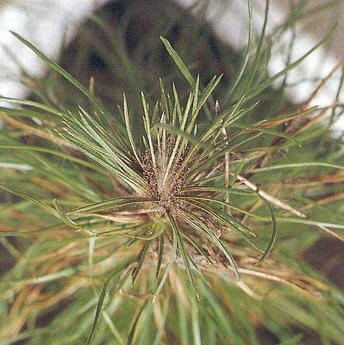PESTS AND DISEASES OF FORESTRY IN NEW ZEALAND
Botrytis cinerea - nursery disease
From Forest Pathology in New Zealand No. 16. Nursery diseases.
Based on Margaret Dick and AL Vanner (1986),
Revised by MA Dick (2008).
Causal organism
Botrytis cinerea Persoon ex Fries

Fig. 9 – Fungal strands and grey powdery fruiting bodies of Botrytis cinerea on the infected tip of a Pinus radiata seedling.
Type of injury
Dieback and occasional mortality.
Diagnostic features
- Death of leaves, needles, and succulent branches and stems.
- Sparse webbing of grey fungal strands on affected parts of the plant (Fig. 9).
- Shoot dieback.
- Grey, powdery appearance of dead tissues.
Hosts
Botrytis cinerea has a wide host range on broadleaved trees and conifers. Undoubtedly, there are many more susceptible hosts grown in forest nurseries than those recorded so far in New Zealand. Araucaria araucana, Cryptomeria japonica, Cupressus macrocarpa, Eucalyptus botryoides, E. delegatensis, E. maidenii, E. ovata,. E. saligna, Pinus brutia, P. muricata, P. nigra, P. radiata, Pseudotsuga rnenziesii, Sequoia sempervirens, Thuja plicata.
Distribution
Throughout New Zealand.
Disease development
Though B. cinerea can invade healthy tissues, it more commonly behaves as a wound parasite, first becoming established on dead or moribund tissue and then spreading into adjacent healthy tissue, where it causes a soft rot of leaves, succulent stems, and branches. The fungus is widely present on dead and dying plant material so that spores are readily available when conditions become suitable for infection. High humidity and moderate temperatures (12-20oC) are ideal for infection. If humidity remains high, infected plants rapidly become covered with a grey mould - the spores and spore-bearing structures of the fungus. The spores are dispersed by air currents and germinate quickly on contact with susceptible host tissue.
Economic importance
Although common and widespread, B. cinerea seldom causes significant losses.
Control
Apply Thiram at a rate of 3.400 kg a.i./ha in 500 to 1 000 litres of water per hectare. E.g. Thiram 40F (400g/l thiram) at a rate of 8.5 l /ha, or Thiram DF (800g/kg thiram) at a rate of 4.25 kg/ha.
Captan products provide control at a rate of approximately 1100g a.i. in 500 to 1,000 litres of water per hectare. E.g. Captan 8OW or (Merpan 800g/kg captan) at a rate of 1.4kg/ha.
Bibliography
Gadgil, P.D. 2005: Fungi on trees and shrubs in New Zealand. Fungi of New Zealand Volume 4. Fungal Diversity Research Series 16: 1-437.
Gilmour, J.W. 1966: The pathology of forest trees in New Zealand. New Zealand Forest Service, Forest Research Institute, Technical Paper No. 48.

 Farm Forestry New Zealand
Farm Forestry New Zealand

